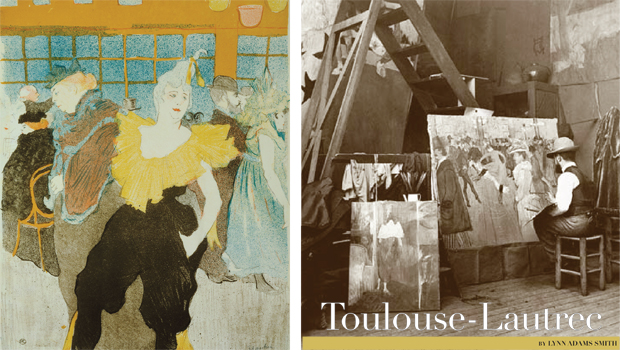Toulouse-Lautrec

By Lynn Adams Smith
Pictured: At the Moulin Rouge: The Clowness Cha-U-Kao, by Henri de Toulouse-Lautrec, 1895
The woman in this portrait was one of Lautrec’s favorite models. She was a dancer, contortionist, and clown, deriving her stage name from the chahut, an acrobatic dance similar to the cancan. Crowds often became chaotic and roared in applause when she performed on stage. Her Japanese-sounding stage name was undoubtedly due to the infl uence of Japonism, the movement inspired by Japanese wood-block prints which was admired by many French Impressionist painters.
ABOUT THE ARTIST:
Henri de Toulouse-Lautrec was a French post-impressionist painter, art nouveau illustrator, draftsman, and printmaker who is best known for his depiction of Montmartre and Parisian cabarets and theaters in late 19th-century France.
Lautrec was born into an aristocratic family from the south of France. His parents were first cousins and his grandmothers were sisters. Lautrec suffered from congenital health conditions, which today, are often attributed to inbreeding. As an adult he was very short, with an adult-sized torso and child-sized legs.
In Paris, Lautrec studied under the acclaimed portrait painter Leon Bonnat. His painting style was influenced by Manet, Degas, and classical Japanese wood prints. Lautrec was good friends with Vincent Van Gogh and made a portrait of Vincent while sitting at a cafe. Theo Van Gogh (Vincent’s brother) was Lautrec’s first art dealer and purchased one of his paintings for his private collection.
Lautrec’s first color lithograph was a poster for the Moulin Rouge, a popular music house located at the foot of Montmartre hill. Three thousand copies of his poster were placed around Paris and Lautrec became an overnight celebrity. His posters were so popular that Parisians were known to follow around the workmen hanging them, so that they could peel them off the walls before the glue dried. When Picasso arrived in Paris in 1900, he sketched a Lautrec poster into one of his own paintings.
Lautrec was well known for creating his art while sitting at cafe and cabaret tables, simultaneously chatting and drinking with friends. He was ridiculed for his physical abnormalities and found solace in mingling with social misfits. He spent a lot of time in brothels and became friends with many prostitutes, sketching them at work and at leisure.
Lautrec died at the age of 36 due to complications caused by alcoholism and syphilis. After Lautrec’s death, his mother, the Comtesse Adele Toulouse-Lautrec, promoted his art and contributed funds for a new museum to house his work.
In 2005, an early Lautrec painting of a red haired laundress, sold at Christie’s for $22,400,000.
More than 100 of Lautrec’s prints and posters are currently on display in a new exhibit at the Museum of Modern Art in New York, including the image on our cover. The exhibit is on view through March 2015.

